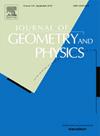The common solution space of general relativity
IF 1.6
3区 数学
Q1 MATHEMATICS
引用次数: 0
Abstract
We review the solution space for the field equations of Einstein's General Relativity for various static, spherically symmetric spacetimes. We consider the vacuum case, represented by the Schwarzschild black hole; the de Sitter-Schwarzschild geometry, which includes a cosmological constant; the Reissner-Nordström geometry, which accounts for the presence of charge. Additionally we consider the homogenenous and anisotropic locally rotational Bianchi II spacetime in the vacuum. Our analysis reveals that the field equations for these scenarios share a common three-dimensional group of point transformations, with the generators being the elements of the Lie algebra, known as the semidirect product of dilations and translations in the plane. Due to this algebraic property the field equations for the aforementioned gravitational models can be expressed in the equivalent form of the null geodesic equations for conformally flat geometries. Consequently, the solution space for the field equations is common, and it is the solution space for the free particle in a flat space. This approach open new directions on the construction of analytic solutions in gravitational physics and cosmology.
广义相对论的共解空间
我们回顾了爱因斯坦广义相对论场方程在各种静态球对称空间的求解空间。我们考虑了以施瓦兹柴尔德黑洞为代表的真空情况;包含宇宙常数的德西特-施瓦兹柴尔德几何;考虑了电荷存在的赖斯纳-诺德斯特伦几何。此外,我们还考虑了真空中各向同性和各向异性的局部旋转比安奇 II 时空。我们的分析表明,这些场景的场方程共享一个共同的三维点变换群,其生成器是 D⊗sT2 Lie 代数的元素,即平面内扩张与平移的半直接乘积。由于这一代数特性,上述引力模型的场方程可以用保角平坦几何的空大地方程的等价形式表示。因此,场方程的解空间是共通的,它就是平面空间中自由粒子的解空间。这种方法为引力物理学和宇宙学中解析解的构建开辟了新的方向。
本文章由计算机程序翻译,如有差异,请以英文原文为准。
求助全文
约1分钟内获得全文
求助全文
来源期刊

Journal of Geometry and Physics
物理-物理:数学物理
CiteScore
2.90
自引率
6.70%
发文量
205
审稿时长
64 days
期刊介绍:
The Journal of Geometry and Physics is an International Journal in Mathematical Physics. The Journal stimulates the interaction between geometry and physics by publishing primary research, feature and review articles which are of common interest to practitioners in both fields.
The Journal of Geometry and Physics now also accepts Letters, allowing for rapid dissemination of outstanding results in the field of geometry and physics. Letters should not exceed a maximum of five printed journal pages (or contain a maximum of 5000 words) and should contain novel, cutting edge results that are of broad interest to the mathematical physics community. Only Letters which are expected to make a significant addition to the literature in the field will be considered.
The Journal covers the following areas of research:
Methods of:
• Algebraic and Differential Topology
• Algebraic Geometry
• Real and Complex Differential Geometry
• Riemannian Manifolds
• Symplectic Geometry
• Global Analysis, Analysis on Manifolds
• Geometric Theory of Differential Equations
• Geometric Control Theory
• Lie Groups and Lie Algebras
• Supermanifolds and Supergroups
• Discrete Geometry
• Spinors and Twistors
Applications to:
• Strings and Superstrings
• Noncommutative Topology and Geometry
• Quantum Groups
• Geometric Methods in Statistics and Probability
• Geometry Approaches to Thermodynamics
• Classical and Quantum Dynamical Systems
• Classical and Quantum Integrable Systems
• Classical and Quantum Mechanics
• Classical and Quantum Field Theory
• General Relativity
• Quantum Information
• Quantum Gravity
 求助内容:
求助内容: 应助结果提醒方式:
应助结果提醒方式:


